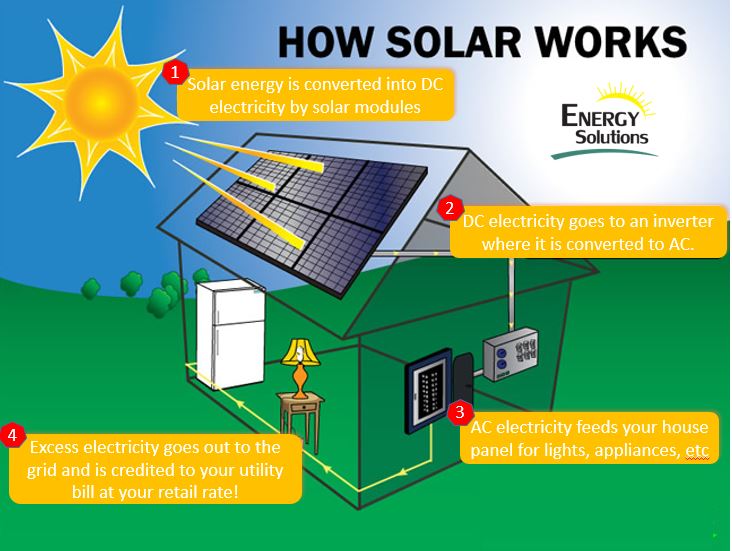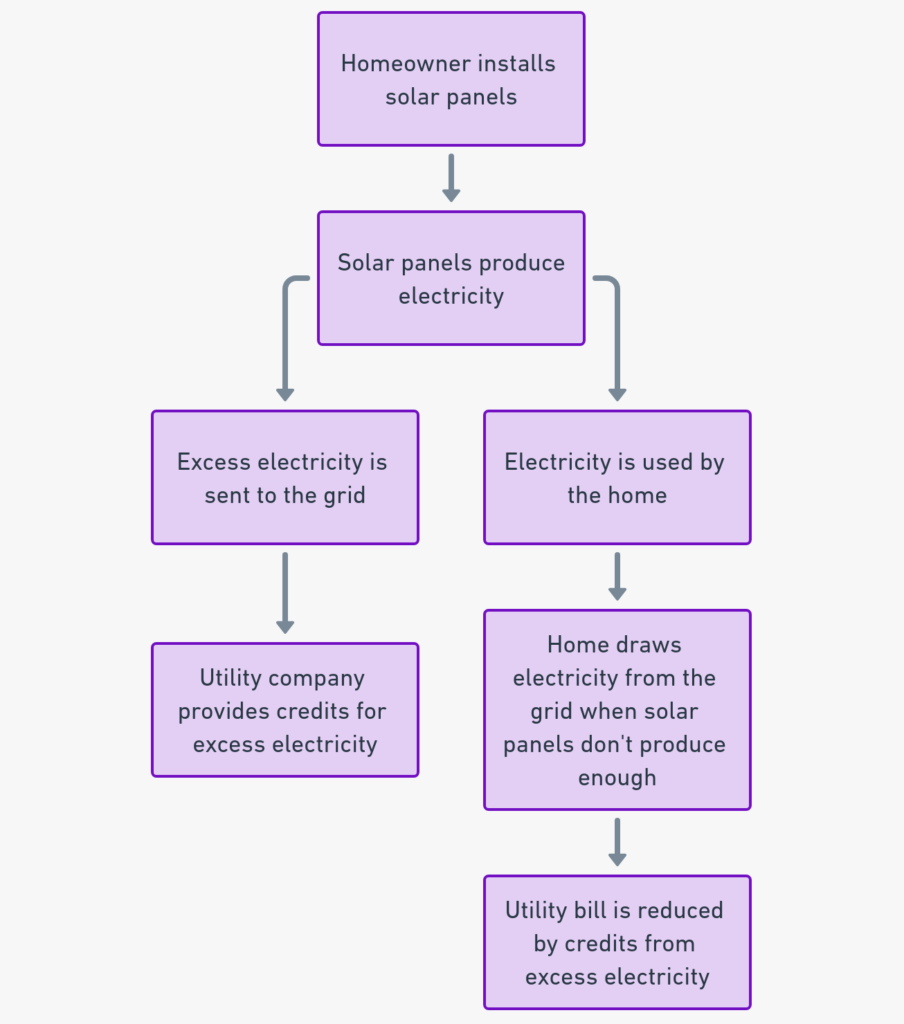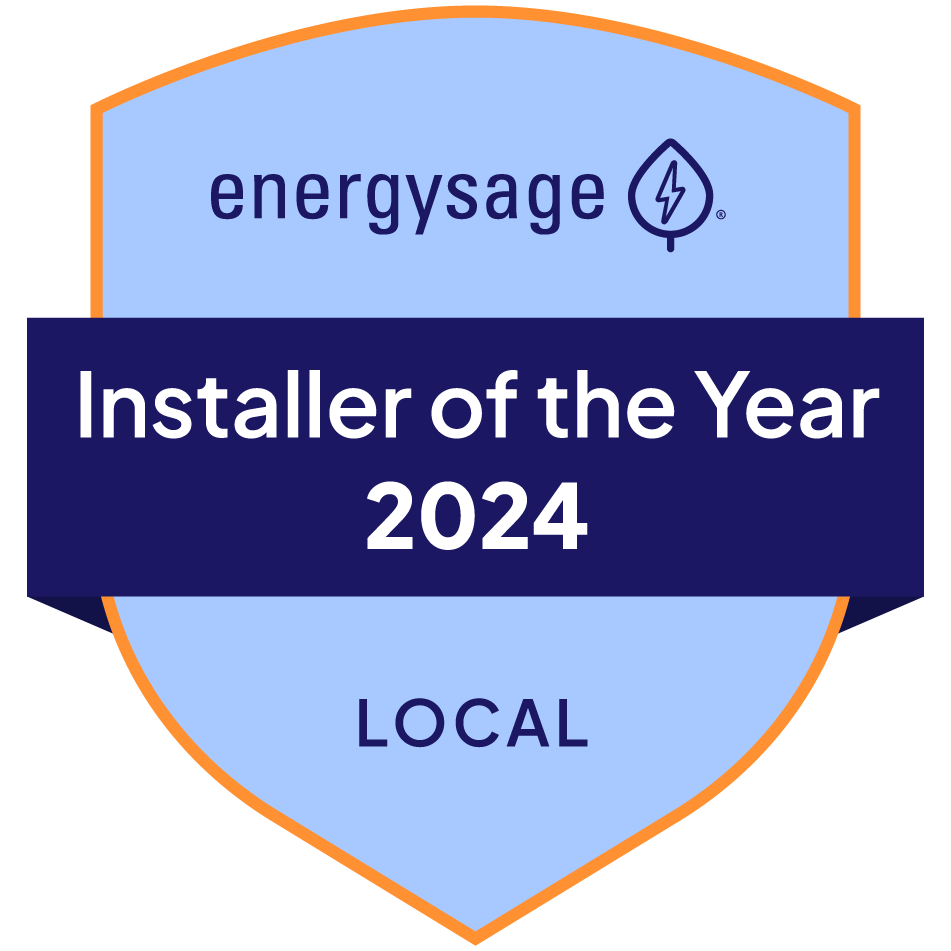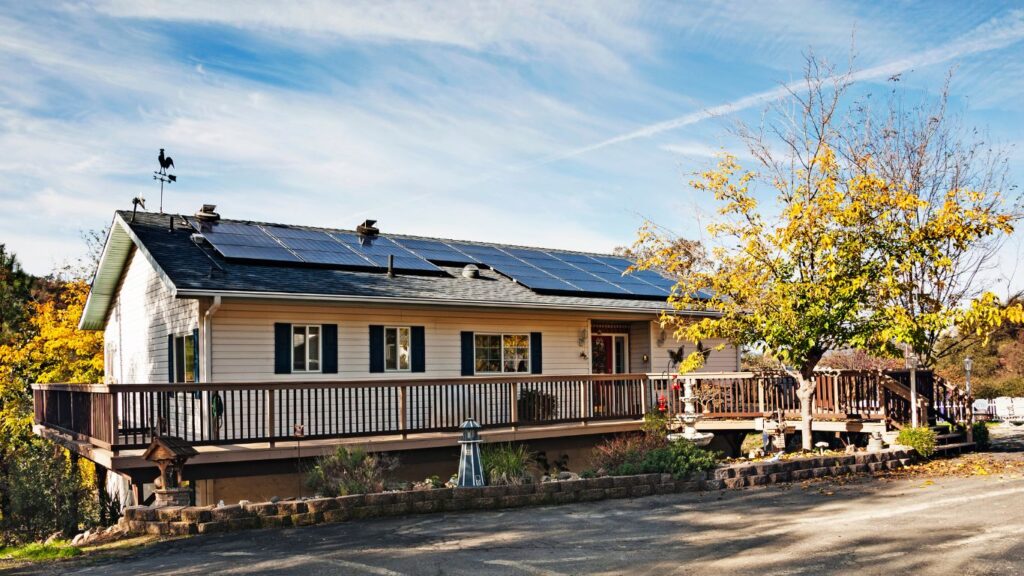Are Solar Panels Worth it in Oregon?
Yamhill County is embracing the shift to solar power. Installing solar panels, either on rooftops or ground, allows residents to harness sunlight for electricity. This move towards renewable energy reduces reliance on traditional power grids and offers many environmental and financial benefits.
This guide simplifies the core concepts of solar power for homeowners, focusing on how the technology works, its suitability in Pacific Northwest weather, and whether solar is worth it in Yamhill County, Oregon.
How Do Solar Panels Work?
Solar panels are composed of many individual solar cells wired together. These solar cells have a special photovoltaic material, usually silicon, that absorbs photons from sunlight. The photons knock electrons loose from their atoms, allowing the electrons to flow freely and generate a current.
The solar cells are wired together in a panel to produce direct current (DC) electricity. This DC passes through an inverter, which converts it into alternating current (AC) electricity that can be used to power homes and appliances.
The basic steps in how solar panels generate electricity are:
-
- Photons from sunlight hit the solar panel and are absorbed by the solar cells.
-
- These photons contain energy that knocks electrons loose in the solar cell material, allowing them to flow freely.
-
- The free-flowing electrons generate a DC.
-
- An inverter changes the DC to AC.
-
- The electricity is then ready for use in the home or to be fed back into the utility grid.

Solar panels produce clean renewable electricity by converting sunlight into an electric current using special materials like silicon. This conversion happens through the photovoltaic effect at the atomic level inside the solar cells. They require no fuel other than sunlight to generate emissions-free power.
What About The Weather?
Contrary to its reputation for rain, Yamhill County enjoys lengthy daylight hours in summer, making solar a valuable investment. Yamhil County solar panels are designed to capture scattered light, effectively converting it to usable electricity even on overcast days.
Why Go Solar in Yamhill County?
Yamhill County’s climate is perfect for harnessing solar energy, with abundant sunshine all year round and rainy seasons offering natural cleaning for your panels. Additionally, Oregon presents favorable solar incentives and rebates for solar installation.
Choosing solar in Yamhill County implies:
-
- Making the most of state incentives and policies
-
- Utilizing abundant sunshine for power
-
- Contributing to a sustainable future
-
- Saving money by reducing or eliminating your electricity bills
-
- Increasing the value of the property
Financial Benefits
Residential solar panels in Yamhill County not only considerably lower monthly electric bills but also provide stability against in raising utiliy rates. Solar power is not just a renewable energy source; it’s a valuable investment with excellent financial returns that many across the county are taking advantage of. Here are benefits to consider:
-
- Reduction in utility bills: By generating your own electricity from the sun’s rays, you’ll rely far less on the grid and slash your utility bills. Depending on your energy usage, solar panels can reduce your electricity expenses by 40-100%.
-
- Stabilization of energy costs: Utility rates often rise year after year, but with solar power, you can lock in consistent energy costs for decades. This protects you from inflation and rising electricity prices.
-
- Increased property value: Homes with solar panels have been shown to sell for a premium compared to similar non-solar homes. Appraisers also factor in expected energy bill savings. This boost in value can significantly outweigh the cost of installation.
-
- Fast return on investment: Between utility savings, incentives, and increased home value, most solar panel systems offer a full return on investment within just 5-10 years of installation. And the panels will continue generating free electricity for another 15+ years beyond that payback timeline.
Installing solar panels in Yamhill County is a savvy long-term investment that pays dividends on your utility bills and protects you from energy costs that will inevitably keep rising in the future. The financial advantages are too significant to ignore for any homeowner.
Environmental Benefits
Switching to residential solar panels reduces the carbon footprint, contributing to a more sustainable future. Solar energy doesn’t emit harmful greenhouse gases and aids in battling climate change. Environmental benefits include:
-
- Reduction in carbon emissions: By utilizing solar power instead of fossil fuel-generated electricity from the grid, homeowners can significantly cut carbon emissions associated with their energy use. This directly decreases their carbon footprint. Solar panels produce no direct emissions while operating.
-
- Conservation of water resources: Fossil fuel energy production consumes vast amounts of water. Solar power eliminates this demand, conserving freshwater resources. This is especially important in arid regions facing water scarcity.
-
- Decrease in dependence on fossil fuels: Widespread adoption of solar energy reduces reliance on polluting energy sources like coal and natural gas. This facilitates a cleaner energy mix for the future.
-
- Promotion of a healthier environment: By curbing air pollution and emissions, solar power contributes to better air quality and environmental health. This benefits public health as well.

The Installation Process
The solar panel installation process is efficient and hassle-free:
Property Assessment
Experts evaluate the property’s suitability for solar panels, considering factors like structure, sun exposure, and energy usage patterns. This allows them to determine the ideal system design and placement.
System Design
A tailor-made solar panel system is designed specifically for the property to maximize efficiency and aesthetics. The experts take into account the roof layout, ideal tilt angles, solar access, and expected energy needs.
Securing Permits
The necessary permits, including building permits and electrical permits, are obtained on the homeowner’s behalf. This simplifies the complex process of navigating local regulations and codes.
Installation
Once the permits are secured, experienced technicians will install the solar panels and other system components. This is when the property begins its transition to solar power.
Testing
Thorough testing and commissioning ensure the system functions as intended before completion. The technicians verify correct wiring, performance, safety, and integration with the home’s electrical panel. If your panel is hold or can’t handle the load, we will recommend upgrading your electrical panel before installing your solar energy system.
Throughout this streamlined process, the homeowner can expect clear communication and exceptional service, making the switch to solar energy simple and straightforward.
Types of Residential Solar Installations
Solar installations in Yamhill County can be customized to accommodate different residential properties. The main types of solar installations are:
Rooftop Solar
Rooftop solar panels are installed directly on the roof of a home or building. This is a popular option for many homeowners as it utilizes unused roof space to generate electricity.
-
- Make efficient use of space, not requiring additional land
-
- Can meet much or all of the home’s electricity needs
-
- Close proximity to the point of use reduces energy loss
Ground-Mount Solar
Ground-mount solar arrays are installed on the ground, often in backyards or open spaces on a property.
-
- Allows flexible positioning for maximum sun exposure
-
- Easily scalable to increase system size
-
- Provides easy access to maintenance

Solar Carports
Solar carports are elevated solar panel structures built above parking spaces or driveways.
-
- Dual function for power and vehicle shading
-
- Utilize existing outdoor parking areas
-
- Visibly demonstrate renewable energy commitment
The right solar installation type depends on factors like available space, energy needs, aesthetic preferences, and local zoning laws. An experienced solar installer can recommend the best option for your Yamhill County home.
Yamhill County Solar Incentives
Yamhill County homeowners looking to go solar can take advantage of several incentives, tax credits, and cash rebates to reduce the cost of installing solar. Here are some of the main solar incentives available in Yamhill County. To view a complete list, please visit our in-depth solar incentive page.
Key Oregon solar incentives
-
- Federal Solar Investment Tax Credit (ITC): This federal tax credit allows you to deduct 30% of the cost of installing a solar energy system from your federal taxes. For the average residential solar installation, this could mean over $7,000 in savings. The ITC is currently set at 30% through 2019, then will begin stepping down year by year.
-
- Oregon Solar + Storage Rebate Program: This state rebate offers up to $5,000 back for installing new solar electric systems. Homeowners who also add solar plus battery backup can get up to an additional $2,500. The exact rebate amounts vary based on factors like income level.
-
- Solar Within Reach: This cash incentive program provides $1.00 per watt installed, up to $5,400, for qualifying low-income Portland General Electric customers. Pacific Power customers can receive $0.90 per watt installed.
-
- Renewable Energy Systems Exemption: This Oregon property tax exemption allows homeowners to avoid higher property taxes from increasing home values after installing a solar energy system. The exemption lasts for 20 years and can save thousands of dollars.
-
- Oregon Net Metering: Utility net metering programs let you get credit for excess solar electricity sent back to the grid. This credit offsets the electricity you use at other times, helping reduce your utility bills.
These incentives are subject to change. Remember to check with a local Yamhill County solar provider for the most up-to-date information. Contact us today!
Net Metering: How Does It Work?
Net metering in Oregon offers a simple but ingenious system for solar panel owners to receive credits for the surplus electricity they generate. Here’s a quick rundown of how those credits work:
-
- Your solar panels may produce more electricity than you use during sunny daylight hours. This excess energy gets fed into the local utility grid.
-
- The utility company installs a special net meter at your home. This meter can spin backward when your solar panels generate extra electricity, unlike a standard meter which only goes forward.
-
- At night or during cloudy weather, when your solar system produces less power, you pull electricity back from the grid.
-
- At the end of each billing cycle, your utility company calculates the net difference between what you took from the grid versus what you supplied back.
-
- If you gave more power than you used, your net meter reading will be negative or in “credit” – and you get rolled over credits on your electricity bill.
-
- Depending on your state’s net metering policies, your utility company may also cut you a check for excess credit over a year.
Here is a diagram to better illustrate how net metering works:

Net metering provides a direct financial incentive for going solar by giving you credit for the extra clean power you produce. Those credits can offset your electricity purchases from the grid when needed. This means that for many solar homeowners, their annual electricity costs drop significantly or even down to $0 by harnessing the sun’s energy.
FAQs About Home Solar Panels
We get asked a lot of questions from homeowners. We believe the more informed you are the happier you will be with your choice. Here is a list of the most asked questions we get about installing solar panels in Yamhill County:
What is the average cost of solar installation in Yamhill County?
The average cost of residential solar installation in Yamhill County is around $2-$4 per watt, depending on system size and other factors.
How much can I save on my energy bills with solar panels?
With solar panels, Yamhill County homeowners can save anywhere from 40-100% on their electricity bills. The exact savings depend on system size, electricity usage, and local utility rates.
How long do solar panels last?
With proper maintenance, solar panels can remain productive for 25-35 years. Many manufacturers offer 20 to 25-year warranties on solar panels.
Can solar panels work on cloudy days?
Yes, solar panels can still generate electricity even on cloudy days, though at reduced efficiency compared to sunny days.
What are the steps to install solar panels?
The main steps are property assessment, system design, permit approval, installation, testing, and interconnection to the utility grid.
Are there rebates or incentives available for solar in Yamhill County?
Yes, Oregon homeowners can take advantage of federal and state tax credits, rebates, net metering, and other incentives to reduce the cost of solar panel installation.
Is Solar a Cost-Effective Choice in Yamhill County?
In Yamhill County, OR, the feasibility of solar energy is underscored by its sunny climate, especially in summer, which is conducive to solar panel efficiency. Installing solar panels can lead to environmental benefits, and notably, a reduction in electricity costs, while potentially enhancing property values.
The availability of financial incentives such as the federal government and local solar incentives can further reduce the initial investment in solar panels. Additionally, net metering can offer economic benefits by providing credits or returns for surplus energy generated.
Considering these factors, solar energy in Yamhill County not only aligns with environmental consciousness but also emerges as a financially sound decision in the long term. Overall, it can lead to significant savings for homeowners.
Now What? Contact a Local Yamhill County Solar Installer Today!
We hope this guide has shown the immense value solar panels can provide for your home in Yamhill County. The next step is to reach out and talk to our solar experts. We offer free solar consultations to assess your property and provide a tailored proposal outlining the costs, savings, incentives, and more based on your specific home.
With over a decade of experience, our team simplifies the process of going solar for Yamhill County homeowners. We handle everything from system design to permits and installation. To get started, call us at 503-647-6793 or fill out our online request form and we’ll be in touch right away.
What to Expect During the Consultation Phase
-
- Evaluate the viability of solar for your particular home
-
- Calculate potential cost savings based on your energy usage
-
- Explain federal, state, and local incentives you may qualify for
-
- Design a custom solar system to maximize sunlight exposure and meet your energy needs
-
- Provide financing options to reduce upfront costs
-
- Guide you through the installation process from start to finish
Take control of your energy costs and help the environment by harnessing Yamhill County’s abundant sunshine. Reach out today to discuss how solar can benefit your household!





